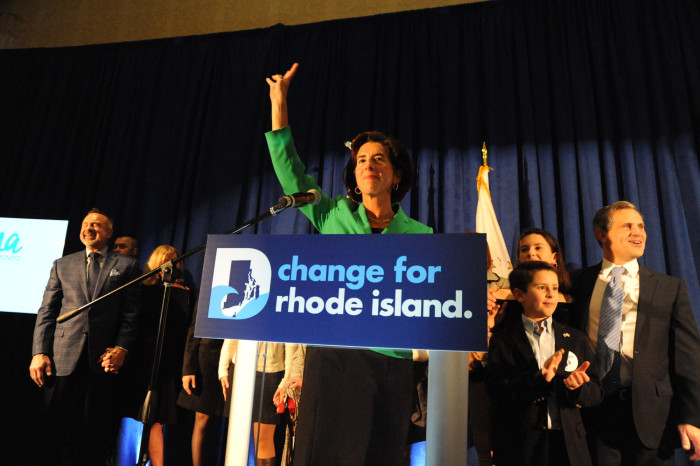Weiss: AARP Survey Gives a Snapshot of Midterm Election Results
Sunday, November 25, 2018
Before November 6, President Donald J. Trump and Congressional Republicans rolled the dice betting on what midterm election issues would propel them to a midterm election victory in retaining control of Congress. But the results were a mixed bag. While maintaining a majority in the Senate, the GOP lost control of the lower chamber.
Many were surprised that the Republican-controlled White House and Congress did not tout an improved national economy, but chose to focus their campaign attack ads on the intense Democratic attack on Judge Brett M. Kavanaugh’s character during his Supreme Court nomination hearing, a caravan of thousands of immigrants marching to the U.S.-Mexico border to escape poverty and violence in Guatemala, Honduras, and El Salvador and law and order. Democrats put their chips on access to health care, Social Security, Medicare, and putting the brakes on skyrocketing prescription drug costs.
Although the GOP maintained control in the Senate (by a majority of 52 to 47), voters put the Democrats in control of the House, with the winning of 232 seats, reaching the magical number of 218 seats, required to take control of the chamber.
GET THE LATEST BREAKING NEWS HERE -- SIGN UP FOR GOLOCAL FREE DAILY EBLASTHealth Care a Key Issue for Voters in Midterm Election
Just days ago, the Washington, DC-based AARP released findings of a national poll of general election voters, along with oversamples in both 39 GOP-held seats that flipped to a Democrat and 37 GOP-held seats targeted as competitive by the Cook Political Report that held for the GOP.
AARP’s bipartisan post-election poll, fielded jointly by Fabrizio Ward and Benenson Strategy Group, found that, for 50-plus voters, Social Security, Medicare, and health care were their top midterm issues, pushing them to vote. The 2,800-voter survey (of General Election voters) also indicated age 50 and over voters across the board are also concerned about bipartisan bickering and gridlock inside the Washington, DC – Beltway, saying they favored a candidate who will work across the aisle.
“Older Americans were crystal clear that health care was the most important issue in this election,” said John Hishta, AARP Senior Vice President of Campaigns in a statement announcing the release of the 22-page report detailing survey findings on November 16. “They want Congress to come together to find commonsense solutions to lowering health care costs and they can start by preventing drug companies from price gouging older Americans and all taxpayers.,” says Hishta.
Adds Tony Fabrizio, of Fabrizio Ward, “Fifty plus voters chose Donald Trump by a wide margin two years ago. This year they were instrumental in Democrats retaking the House. They have become a formidable swing voting block for 2020.”
“This election made it clear that candidates and parties can't build a winning-coalition without older Americans – or take their vote for granted,” said Amy Levin, Partner Benenson Strategy Group.
Taking a Closer Look…
The AARP survey revealed that while voter survey respondents under age 50 were more likely to identify as Independents, those age 50 and over were most likely to affiliate as either Democrat or Republican.
According to the AARP survey, for age 50-plus voters, concerns about Social Security (83 percent), Medicare (79 percent) and health care (79 percent) were their top midterm issues. However, younger voters find education (67 percent), health care (64 percent) and the economy (66 percent) to be most important to them.
The findings clearly show that the surveyed voters sent a message at the polls on November 6 that they want Democrats and Republicans to govern and not to not get mired down in political gridlock. In GOP-held districts that Democrats flipped, 63 percent of the age 50 and over voters wanted elected officials to work in a bipartisan manner. For districts the GOP held, 65 percent of voters felt the same way. While voters of both political parties expect more political gridlock, younger voters surveyed were even more pessimistic when compared to age 50 voters that this could happen.
AARP’s post-midterm election survey revealed that a pink wave was key in electing Democratic candidates, say the pollsters. Age 50 and over women were instrumental in the Democrat’s in gaining House seats -- they favored a Democrat for House by 12 percent in the districts Democrats flipped.
The AARP survey found that the majority of survey respondents approved many of Trump’s policies, while almost 2/3 disapproved of him personally. The pollsters also noted that in districts held by the GOP, 55 percent of age 50-plus voters approved of President Donald Trump’s policies and 38 percent approve of him personally.
But the AARP survey revealed that voters nationally and in Dem Flips wanted a check on Trump, especially the independent voters. Obviously, GOP Hold districts voters were more favorable to Senate and House candidates who supported Trump ‘s policy agenda. Age 50 and over voters wanted a check on Trump (by 6-points), this being smaller than the margin of voters under age 50.
Both Democratic flips and GOP Hold Districts were whiter and older than the nation as a whole, but Democratic Flips took places in districts that were more suburban, educated and affluent. But, key to the Democratic national successes in both the Dem Flip & GOP Hold segments was Independents age 50 and over voting Democrat by double-digit margins across the board.
Meanwhile, while less Democratic-friendly than voters under age 50, those age 50 and over narrowly favored the Democratic candidate both nationwide and in districts Democrats flipped from Republicans. And, their support for Republican candidates in the GOP Hold districts helped Republican losses from being even worse.
In October, AARP released, a 52-page report, “2018 Mid-Term Election Voter Issue Survey,” that found that the majority of those surveyed said that they would vote for candidates that supported lowering health care costs, strengthening and reforming Social Security and Medicare, putting the brakes to skyrocketing prescription drug costs. AARP’s post-election survey clearly mirrors these priorities.
With the 116th Congress convenes on January 3, 2019, Republican and Democratic lawmakers along with President Trump must work to put aside their political differences and govern by crafting bipartisan legislation that benefits the nation. As can be seen by AARP’s bipartisan post-election survey, voters demand this.
For more details on the survey’s findings, call Colby Nelson at (202) 434-2584 or email, [email protected].
Herb Weiss, LRI’12, is a Pawtucket writer covering aging, healthcare and medical issues. To purchase Taking Charge: Collected Stories on Aging Boldly, a collection of 79 of his weekly commentaries, go to herbweiss.com.
Related Slideshow: Election Night 2018: Photos of Democratic Heaven and GOP Hell in RI
Related Articles
- Weiss: In 2050, Where Have All the Family Caregivers Gone?
- Weiss: House Fails to Pass GOP’s Balanced Budget Amendment
- Weiss: “First They Came for the Jews…”
- Weiss: A Storm Cloud Looms Over Older Americans Month
- Weiss: Keynote Address - Fine Calls for Community Health Stations in Every RI Community
- Weiss: With Tax Day Looming, Watch Out for IRS Imposters
- Weiss: New Report Says Alzheimer’s Disease Is Now Major Public Health Issue
- Weiss: Pets Can Bring You Health, Happiness
- Weiss: Older Americans to Benefit from Bipartisan Budget Act
- Weiss: Trump’s Budget Proposal Comes ‘Dead on Arrival’ to Aging Groups
- Weiss: Efforts to Revise State Alzheimer’s Plan are in Full Swing
- Weiss: Trump Signs Legislation to Undo Nation’s Banking Rules
- Weiss: AARP Gives Us a Snapshot of the Millennial Caregiver
- Weiss: AARP Takes a Look at the Prescribing of Dementia Drugs
- Weiss: Senate Spending Bill Increases Research Dollars to Combat Alzheimer’s
- Weiss: Democrats Listening to Calls to Strengthen & Expand Social Security, Medicare
- Weiss: Midterm Elections are Here - Your Vote Sends a Message to Congress
- Weiss: Midterm Elections Can Impact Social Security’s Long-Term Survival
- Weiss: Calls for Strengthening Medicare at its 53rd Anniversary
- Weiss: RI Authors Give Advice to Graduating College Seniors
- Weiss: Splaine Consulting Gears Up to Update State’s Alzheimer’s Plan

































































